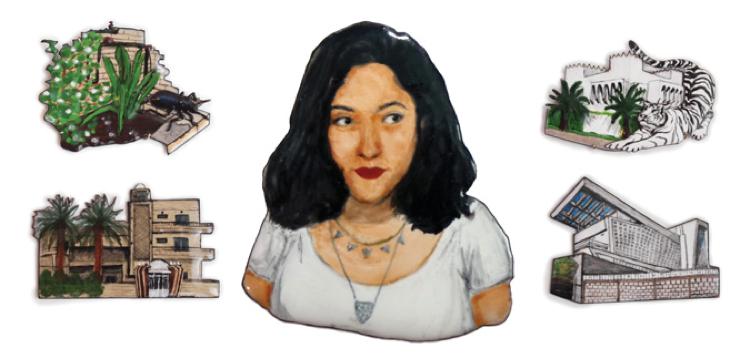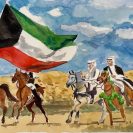When Muneera Alsharhan would go to a shopping mall she people watched. She took in outfits and styles, mannerisms and silhouettes. She observed how her fellow citizens continuously change hijab styles, eyebrows and silhouettes to define themselves in their globalized home. Then, she went home and drew them.
“That was so interesting to me,” she said. “I wanted to record it because it was changing so quickly. I thought ‘no one is going to remember it was like this at one point’. So I took the way I looked at people, and people watching and looked at houses.”
Well known for her jewelry designs, Alsharhan was given the opportunity to develop her artistic talents when she was selected for the Out of Kuwait art residency program sponsored by the British Council. She was sure she wanted to do something that touched on memories lost, or fading, from the Kuwait collective memory. She recalled a show in The Contemporary Art Platform (CAP) on 100 years of British landscape. Artists had painted landscapes that preserved their unique impression of England, and became part of the collective memory. Alsharhan wanted to do the same, and go beyond the pearl diving, mud home memories she had been told about, and capture the actual memories she had growing up.
“I’ve never lived that and I have never seen that,” she said. “I don’t identify with it except for the fact that it’s imposed on me as something that is a part of me. So I started thinking about childhood memories and what I could remember from landscapes.”
She remembers vividly the specific houses she looked forward to seeing every morning on her way to school. There was the pink house rumored to have a crocodile. Her driver had her convinced that the white house down the road housed a tiger. Then, there was a small home at the corner of her block that mystified her with beetles she wasn’t afraid of.
To Alsharhan, these memories, the homes people were building and the unbelievable things they housed in them, were a very important part of Kuwaiti culture that is getting lost in the rapidly changing landscape. So she set out to create My Kuwait Enameled Series, a collection of miniature renditions of the homes built in Kuwait from the early 60’s to the early 80’s that stood out the most in her childhood memories.
“Things move very quickly in Kuwait and they change things without thinking,” she said. “I wanted to document those houses before they disappeared. My kids are going to come, and the buildings from our life time are going to have disappeared and they are not going to see how we are living.”
She first attempted to create ceramic renditions of the homes with a rented pottery wheel from Bayt Lothan. However, she quickly realized that while she had taken a single class on in ceramics, she couldn’t capture the pieces the way she wanted to in due time. So, she decided to go back to her forte, enameling.
Enamel is a powdered glass, set on any metal and then heated so it melts and sets. A particle of dust, an extra second in the oven or a simple sneeze and the piece is ruined. Alsharhan had to deep clean her whole study after her dusty ceramic experience so that none of it got into the enamel, which would have caused the piece to pop off the copper base.
The result was a collection of the 16 most important homes and scenes to Alsharhan. They included the animal houses, the buildings that define Kuwait and even the ice cream man sitting beneath an umbrella under the blazing sun, selling ice cream in mid summer.
She was nervous when she arrived in London for the Edge of Arabia exhibit. Visitors of the gallery in Kuwait related to her pieces because they were buildings and homes they knew. She worried that the London audience may not understand the significance of her work, and they may be lost in the midst of large pieces. Yet, gallery visitors walked right up to her pieces, arranged relative to her own home as if on a Kuwaiti map, and inspected every detail even attempting to see the back of it. The process intrigued them, but Alsharhan was pleasantly surprised to find that people connected to the buildings. They said they too had family homes like the ones depicted in her pieces.
For Alsharhan the popular reception she received at the show was just the icing on the cake. She had set out to document an era in Kuwait she fears will one day be lost, and she succeeded.
“Maybe we don’t like it,” she said. “But we can’t pick and choose which part we want to remember and which part we don’t. So we have to be careful and not forget so quickly.”
For more on Muneera Alsharhan’s work visit her website www.muneeraalsharhan.com . You can follow her on Instagram











